Why Is Copper Sulfate Blue?
Like many transition metal complexes, copper (II) sulfate pentahydrate is brightly colored; crystals of this beautiful substance are a pale shade of blue. Its color stems from the chemistry and physics of its composition — or, more specifically, the kind of bonds it forms with the sulfate ions and water molecules attached to the copper.
Orbitals
Orbitals
Electrons exhibit wave-particle duality, meaning they have both wave-like properties and particle-like properties. The behavior of an electron in an atom is described by a wave-like equation called a wavefunction. The square of the wavefunction gives the probability that the electron will be found at any one particular point at any one given time. The wavefunctions of electrons in atoms are also called atomic orbitals. Chemists name atomic orbitals by using a number to designate the energy level of the orbital followed by a letter to designate the type of orbital. For elements in the fourth period of the periodic table or above, you only need to focus on three types of orbitals, namely, s, p and d. To get a feel for the shape of these orbitals, see the link in the resources section.
Crystal Field Splitting
Crystal Field Splitting
The copper ion in copper (II) sulfate has lost two electrons, so it has a +2 charge. It has nine electrons in its outermost energy level or shell; these so-called valence electrons all occupy 3d orbitals. The water molecules and sulfate ions are attracted to the positive charge on the copper ion, so they approach it and arrange around it in an octahedral configuration. Consequently, two of the copper ion's five 3d orbitals align along the axes by which the sulfate ions and water molecules approach; since the electrons in these orbitals and the electrons in the molecules/ions both have negative charge, they repel each other. Ultimately, then, two of the five 3d orbitals have increased energy; these are called the eg orbitals. The other three, by contrast, have decreased energy and are called the t2g orbitals.
Absorption of Light
Absorption of Light
A photon of light will be absorbed by the coordination complex if it has an energy equivalent to the difference between the state an electron now occupies and the energy of another state available to it. Consequently, the copper sulfate complex can absorb photons of light with energies equivalent to the difference in energy between t2g and eg orbitals. As it happens, the difference in energy for the copper sulfate complex is equivalent to the difference in energy for photons of light in the red-orange region of the spectrum. Since reddish light is absorbed while blue light is transmitted, the copper sulfate appears blue.
Dissolving in Water
Dissolving in Water
When the copper sulfate dissolves in water, the copper and sulfate ions dissociate. Now the copper ion forms an octahedral complex where it's surrounded by six molecules of water. The effect is still very much the same, however, because the split between t2g orbitals and eg orbitals in this new complex is still such that reddish-orange light is absorbed and you see a blue-colored solution.
References
- "Chemical Principles, the Quest for Insight, 4th Edition"; Peter Atkins et al.; 2008
Cite This Article
MLA
Brennan, John. "Why Is Copper Sulfate Blue?" sciencing.com, https://www.sciencing.com/why-is-copper-sulfate-blue-13425833/. 21 July 2017.
APA
Brennan, John. (2017, July 21). Why Is Copper Sulfate Blue?. sciencing.com. Retrieved from https://www.sciencing.com/why-is-copper-sulfate-blue-13425833/
Chicago
Brennan, John. Why Is Copper Sulfate Blue? last modified March 24, 2022. https://www.sciencing.com/why-is-copper-sulfate-blue-13425833/
